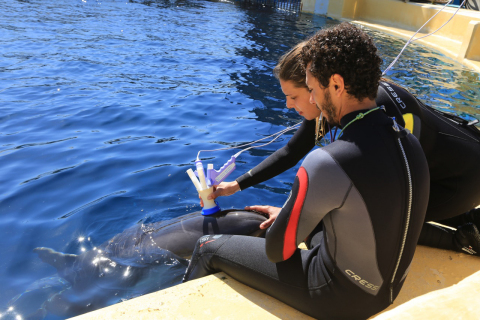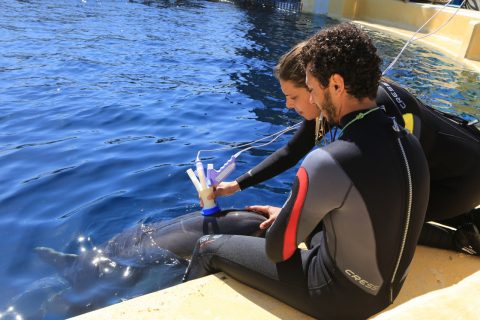ANDOVER, Mass.--(BUSINESS WIRE)--Researchers are using mobile ultrasound technology and software developed by ndd Medical Technologies to measure pulmonary function in dolphins, whales and other sea animals. They hope to answer puzzling questions about dive physiology and aquatic mammal disease and behavior, which may lead to better understanding and treatment of lung problems in humans, including those that afflict premature babies.
“For 75 years, people have been trying to collect effective lung function measurements in dolphins and whales but have lacked the mobile diagnostic tools that are available for humans,” explains veterinarian Micah Brodsky, VMD, of Micah Brodsky V.M.D. Consulting. “Our thought was to build on ndd’s tried and true equipment —used for years to measure pulmonary function in humans. Their devices have been subjected to extensive validation testing and are well understood so they were the perfect tools to use, whether on the beach triaging stranded dolphins, in a research facility, or at an aquarium.”
Working with ndd Chief Technology Officer Christian Buess, PhD, Dr. Brodsky and Andreas Fahlman, PhD, have developed a prototype lung function device made up of four ndd sensors, whose patented Ultrasonic TrueFlow™ technology requires no calibration and eliminates problems associated with traditional methods of flow measurement. Drs. Brodsky, Fahlman, and collaborators hope to begin field-testing the device on dolphins within the next few months. Dr. Fahlman is head of the comparative physiology laboratory and assistant professor at Texas A & M University Corpus Christi.
Working with organizations and facilities around the globe, the pair is seeking to answer key questions such as how the lungs of dolphins and whales collapse when they dive, then re-expand as they come to the surface. For some marine mammals, this can occur more than a hundred times a day. The answer could yield insights into human pulmonary disease processes as well as conditions like atelectasis (the partial or complete collapse of a lungs) and the bends—a potentially lethal danger for human divers and marine mammals. The implications of this research could also help scientists better understand the impact of things like climate change and food availability on aquatic mammals. Drs. Brodsky and Fahlman believe they will be able to extrapolate the data they gather on dolphins to large, free swimming whales.
The pair is exploring uncharted waters. “Despite an abundance of very good theories and models, there is a paucity of published experimental data on the respiratory function and lung mechanics of dolphins and whales,” says Dr. Brodsky. Testing in dolphins and whales is extremely challenging because of how fast they breathe and the sheer volume of gases exchanged. While point-of-service diagnostic imaging tools do exist for marine mammals— for example x-rays and ultrasounds— the information collected does not measure the function of this important organ system, and animals must often be removed from the water, which can be stressful to their bodies and affect the measurements. The animals would not have to be taken out of the water to use the new device, which is simply held over their blow hole.
In the meantime, the scientists are already using ndd spirometers to measure lung function in seals and walruses, and have also applied the technology to endangered loggerhead sea turtles, which can be inadvertently caught in fishing nets. “ndd Medical is helping us with animal conservation. There’s very clear evidence that turtles get decompression sickness when they’re brought to the surface quickly,” says Dr. Fahlman. “If we can understand what happens, we’ll be able to treat them more effectively when they’re caught.”
About ndd Medical Technologies Inc.
With 40 percent of the U.S. spirometry market share, ndd Medical Technologies offers innovative, easy-to-use pulmonary function testing instruments that help clinicians diagnose lung disease with greater precision for optimal treatment. Its EasyOne® and EasyOne Pro portable instruments take up just 12 square inches of space and take lung function testing wherever it is needed, measuring DLCO, FRC, LCI and FVC. ndd’s patented Ultrasonic TrueFlow™ technology requires no calibration and eliminates problems associated with traditional methods of flow measurement, making testing fast, reliable and error free. To learn more, visit www.nddmed.com.




